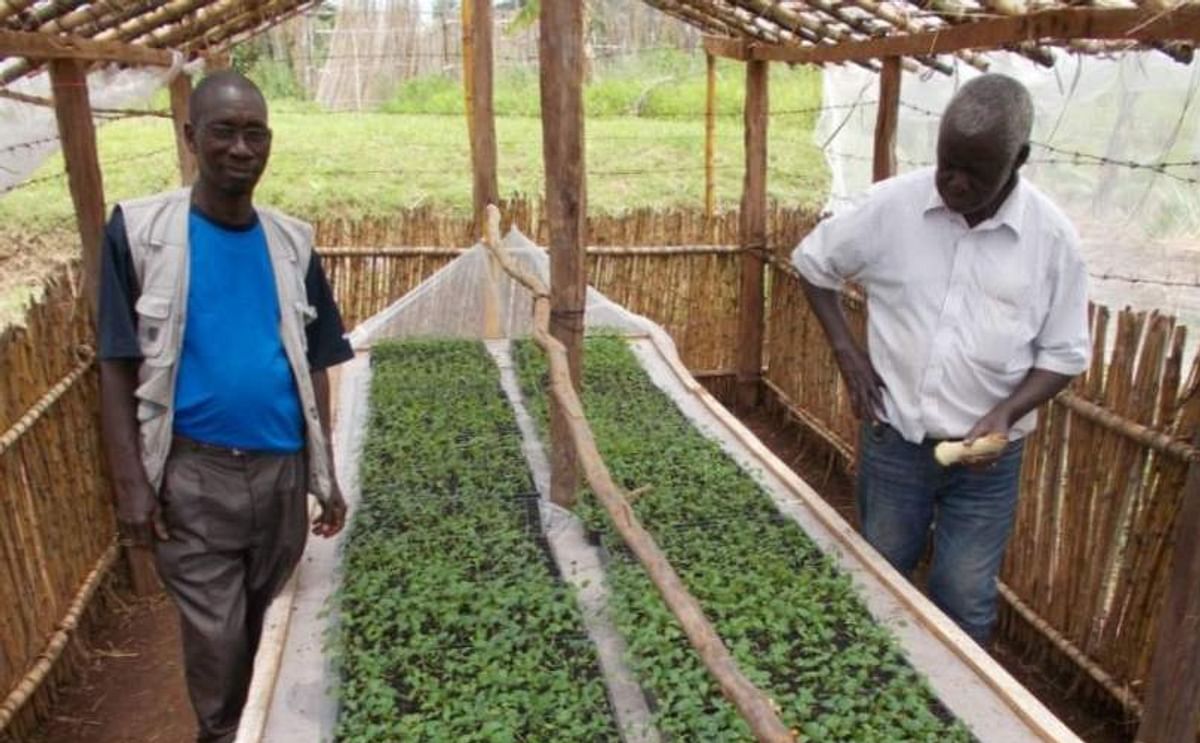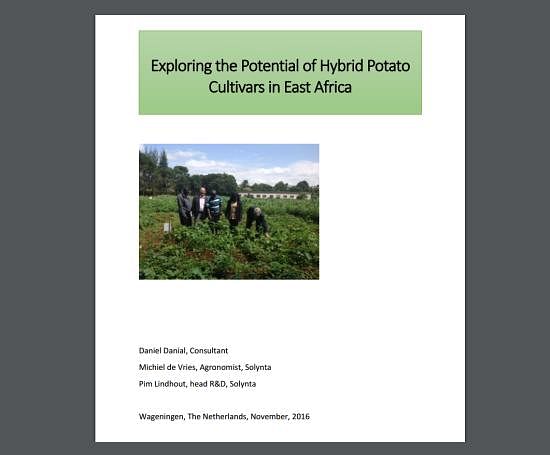Potato seedlings grown from true potato seed
Solapas principales
The potential of hybrid potato cultivars in East Africa

The Food & Business Knowledge Platform - a knowledge platforms focused on food security initiated by the Dutch Ministry of Foreign Affairs - supported a fact-finding mission in East Africa to explore the potential of the usage of hybrid true potato seeds (TPS) for this region, and to identify interested partners from both private and public sectors to support research, development and commercialization of this technology.
The mission was implemented by Solynta and took place in six countries: Tanzania, Kenya, Uganda, Rwanda, Democratic Republic of Congo and Ethiopia.
Hybrid Breeding Technology for Potato
A new hybrid breeding technology has been developed to accelerate breeding activities and propagation of starting materials. This technology enables breeders to develop new potato cultivars that are attuned to the needs of the local producers and markets, much more rapidly than conventional breeding. In addition, the high performing products are uniform hybrid true seeds.

A single potato seed (Courtesy: Solynta)
Tens of millions of true seeds can be produced within one growing season, which are devoid of any pathogen. Potato true seeds have a logistical edge compared to seed-tubers: they are far smaller, only 20 grams instead of 2500 kg is needed for one hectare. These true seeds are clean, disease-free and easy to ship and can be stored for years.
This technology has been developed by the Dutch company Solynta that has been awarded as National Icon by the Dutch Government.
The Potato in East Africa
Potato is a major food crop contributing to food security in East Africa. It is an important cash crop and is widely grown by small-scale farmers in the highlands. The production of the crop in East Africa has more than doubled in the last 20 years.
The single most important constraint, that prevents productivity and profitability in the potato value chain, is the lack of high quality starting material. Currently farmers use heavily diseased, expensive, perishable and bulky seed-tubers mostly reusing from last season harvest, which lower the usable yield and demand conditioned storage.
Other limiting factors are:
- lack of well adapted high yielding cultivars
- high incidences of diseases
- inadequate crop management
- poor soil fertility
- inadequate ware potato storage facilities and
- poorly organized commercialization
Using uniform hybrid true potato seeds would eliminate this problem. Results of initial trials1, showing that hybrid potato has the potential to more than triple yield 29 tons/ha instead of 8 tons/ha which is the current local average, were presented at the African Potato Association Congress. Clearly showing its break through potential for East Africa’s food security.
Workshops
In each country, a workshop was organized with national stakeholders in the potato food chain to discuss the concept of hybrid potato and to setup research and development activities to study the potential of hybrid potato at the national level. The stakeholders became familiar with the concept of hybrid potato and understood the advantages when compared to the conventional potato breeding technology.
The two most evident advantages are:
- The availability of disease-free true hybrid seeds, that can be produced in large quantities in only one growing season and hence provide excellent clean starting materials for the local potato production systems, which are easily shipped and not perishable;
- The fast and dedicated co-creation of hybrid potato cultivars that are adapted to local conditions and to the needs of the local stakeholders in the potato food chain.
Adaptation
It is also well understood that the introduction of hybrid potato seeds requires adaptations of the cultivation technologies and distribution systems. Especially, the dissemination of knowledge, technologies and materials, that are typical for potato hybrid seeds, may offer the greatest challenge. The adoption of hybrid potato seeds for the benefit of all stakeholder in the value chain in East Africa can only successfully be achieved in coordinated actions of private and public partners. A major part of the workshops focused on this multi-stakeholder approach.
(Click to access full document) 
Solynta Report: Exploring the Potential of Hybrid Potato Cultivars in East Africa
For a sustainable potato food network, improved access to the market and market intelligence is a prerequisite. Several companies and institutions have shown their interest to join research on hybrid potato.
Socio-economic Context
The socio-economic context is a major determinant of opportunities. There was sometimes criticism about the role of private industry in strengthening the potato food chain and contributing to food security in East Africa. Some participants were initially reluctant to accept the idea that a commercial partner is motivated to invest in research on the potential of hybrid potato mainly for reasons of strengthening the regional food security. Subsidized actions are needed to enable capacity building, to kick-start the creation of an ecosystem, in which all stakeholders are present. For such a system to be successful, variety registration, protection, seed certification access to quality inputs and trust need to be assured. On the long term, subsidies are not the solution for a sustainable potato food chain. It should and can generate a profit for all participants to be self-sustaining.
No representatives of farmers’ groups participated in the workshops. It was considered as too premature as no hybrid potato products are in the market yet. Still, the other participants showed strong and often quite different opinions about the acceptance of hybrid potato by farmers. Some believed that convincing demonstration plots should cause the easy acceptance by farmers, while others believed that farmers will show resistance for new technologies anyway. It will be difficult to predict the farmers’ reaction and building trust of the farmers is a prerequisite.







